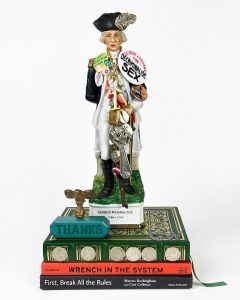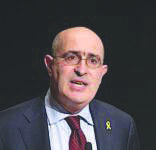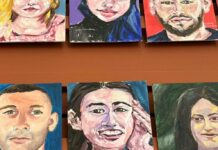
Bedecked in a gold chain, a Sharpie-tattooed heart on his face, a rainbow pin draped from his torso and an evil eye — harkening to a Jewish superstition — around his neck, the statue of George Washington is still recognizable as the American forefather in John Y. Wind’s sculpture.
But instead of merely representing America’s first president, the sculpture shows all that America can be in terms of political and personal identities, represented in knickknacks strewn on top of and around the leader’s body.
Washington is one of several American Revolution heroes to whom Wind gives the assemblage treatment. In “Whiskey Rebellion,” Jewish, Israel-born artist Wind challenges the masculinity and heroics of the country’s early leaders, giving them expansive American identities that address the country’s racism, antisemitism and homophobia in the process. The exhibit is on display through Nov. 27 at the Hyatt Centric in Center City.
Part of the hotel’s monthly “Maker Series,” the exhibit is an avenue to draw attention to Philadelphia artists from visitors, as well as to draw locals to the hotel.
The series began earlier this year, and Wind’s works, perched on the hotel’s lobby bookshelves, will be the series’ first sculptural installment.
“Not only is that just creating a truly different vibe in our lobby, but he’s also showcasing the history of not just Philadelphia, but America in general, in a totally different light,” said Elizabeth Fricke, Hyatt Centric Center City director of sales and marketing.
With a background in jewelry and found object sculptures, Wind became fascinated with a collection of American hero-themed whiskey decanters he found in his fiance’s grandmother’s basement shortly after her death.
The figures — representatives of all 50 states — sat in Wind’s South Philadelphia studio for months, until he was asked to participate in the Maker’s Series.
“I knew it would include some kind of transformation; I knew it would include poking fun at their heroic presentation; I knew it would include the language of jewelry,” Wind said of the exhibit.
The name of the exhibit “Whiskey Rebellion” is a reference to the 1794 uprising of farmers and distillers after the freshly formed U.S. government under Washington enforced a whiskey tax. Wind wanted to similarly challenge Washington’s authority.

As a gay, Jewish man, Wind, 61, intended to comment on the growing polarization of American politics, drawing on humor and irreverence to transform stoic, upright American heroes into symbols of pluralism and multifaceted identities, confronting their legacies as red-blooded men and rugged champions of democracy.
In addition to Washington and Thomas Jefferson, Wind gives assemblage makeovers to the foreign-born Thaddeus Kosciuszko and Napoleon Bonaparte in the exhibit.
“I’m really interested in portraiture, and how objects in our lives represent different aspects of who we are,” he said. “That’s digging into the individual. But then, because these objects are familiar and relatable [to] others, it takes it from the specific to the general.”
Wind refers to most of his sculptural pieces as “portraits,” in the sense that they represent a singular person or idea. In other projects, he’s drawn on personal stories as inspirations for his pieces.
In “Portrait of Zoltan,” a 2021 piece, Wind sculpts a portrait of his grandfather Zoltan Windt in the form of a suitcase filled with tchotchkes, heirlooms and photographs.
In 1932, Windt emigrated from Hungary to Haifa, British Mandate Palestine, the precursor to the state of Israel. He originally came as a tourist and fell in love with Wind’s grandmother, whose parents owned the penzion, or hostel, where Windt stayed. The couple owned a men’s clothing store for 40 years.
After Windt died in the 1990s, Wind began collecting his grandfather’s leftover belongings, including his Israeli passport, which features in the piece.
“I’ve always been the family archivist and the one who keeps the stuff,” Wind said.
Like his immigrant grandfather, Wind has also reckoned with his identity. Born Yaron Windt, Wind changed his name to Jaron, and later John, upon moving to the United States at age 3, hoping his name would be easier to pronounce. The push and pull of his identities is something featured in his work explicitly and implicitly.
As he reflects on depicting American heroes in “Whiskey Rebellion,” he feels the tension of both revering American history but also feeling alienated from it.
“As an immigrant, and as a gay man, I’ve also always been aware of having an outsider status,” he said. “And that shapes the way that I approach these figures.”






